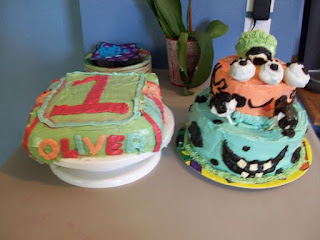We're way out of date—the first birthday cake I'm about to show you (that would be the first cake for a first birthday) was for a nephew who just this year turned four, so... yeah. But, begin at the beginning, right?
The Monster Cake
This was a fun cake. It was a ton of work, but I'd actually love to do it again because I have learned so much since then. First of all, I would make it less droopy.
This cake overcame such baking obstacles as:
- The cake won't keep its structure.
- The cake won't bear the weight of stacking.
- The cake pops are falling apart when we dip them.
- The dogs ate half the cake.
You're Probably Thinking Too Big
 |
| Sketch of the Grand Idea |
Now I'm more realistic in basing the cake size on number of servings. Search for a cake serving chart, and you'll see that an ordinary two-layer round cake can serve up to 20 people depending on how you slice it. (Although I know a certain family member who would just as well slice any round dessert into eight humongous servings and call it day). And, know your crowd. Often you can count on a small percentage who aren't going to eat any cake.
Freeze the Cake Balls and Shorten the Candy CoatingNot pictured except in my "grand idea" sketch were the cake pops we also made to complement the monster cake. We decorated a few of them to look like eyeballs and various little monsters until things got frustrating (cake balls falling apart, Candy Melts getting clumpy) and we were running out of time, and then we simply dipped them in clumpy white Candy Melts. Ta-da!
Cake balls or cake pops (just add a stick and now it's a fad!) can be easy if you follow some basic rules. They can be a picturesque fail if you don't. Form the balls, stick the sticks and then freeze them before you start dipping them in the melted candy coating.
Overheat the Candy Melts and they get clumpy. So microwave them gently and stir, stir, stir. If there are still some solid pieces, stir some more until they melt. It is OK to reheat them several times as needed, but for only 20 seconds at a time on a low power. The melted Melts are still rather thick and not an ideal dipping medium. Add a spoonful of melted shortening (vegetable oil also works) to slightly thin out the coating, and now dipping those cake pops is a cinch. Yeah, I said it.
Moisture and Structure are (Somewhat) Mutually Exclusive
Almost all cake mix boxes are labeled "super moist deluxe" or some such thing, but they're really just ordinary cake, aren't they? Plain old ordinary cake is what you want for a sturdy structure. The cakes that are truly super moist, like the ones with pudding in the mix or your chocolate cake recipe that calls for mayonnaise, are delicious for an ordinary-sized single or double-layer cake with no fancy stacking or shaping. But the extra delicious moisture provides no solid foundation and will not reliably support multiple tiers. The dowels are wont to tilt in that squishy loam of deliciousness.
 We originally
planned for a four-tier monster of a monster cake: A square on the
bottom with fun stripes and birthday boy's name, then a round tier
decorated as a blue and black polka-dotted monster with a toothy grin
and googly cake ball eyes, topped with an orange monster with more cake
ball eyes plus a tail that wrapped round the back, and a green hairy
one-eyed cupcake-sized monster on top as the baby's personal "smash
cake." The weight of the tiers was too much for the moist delicious
cakes to hold, so the bottom tier became its own separate cake. We
simply frosted over the mess on its surface caused by all the attempted
stacking and piped on a giant number 1. In case anyone wasn't sure which
birthday this was.
We originally
planned for a four-tier monster of a monster cake: A square on the
bottom with fun stripes and birthday boy's name, then a round tier
decorated as a blue and black polka-dotted monster with a toothy grin
and googly cake ball eyes, topped with an orange monster with more cake
ball eyes plus a tail that wrapped round the back, and a green hairy
one-eyed cupcake-sized monster on top as the baby's personal "smash
cake." The weight of the tiers was too much for the moist delicious
cakes to hold, so the bottom tier became its own separate cake. We
simply frosted over the mess on its surface caused by all the attempted
stacking and piped on a giant number 1. In case anyone wasn't sure which
birthday this was.Icing Covers All Flaws
With the exception of deteriorating structural integrity, icing can mask just about any mistake on the cake, as mentioned just a few lines ago. Crooked line? Wipe it of and ice a new line over it. A misshapen edge? Just add more icing and smooth it out. Dogs ate half the cake? Bake more cake for a replacement section and use icing to glue it all back together.
"Remember this is the side the dogs bit off of, and we just won't serve any pieces cut from this side, OK?"



No comments:
Post a Comment